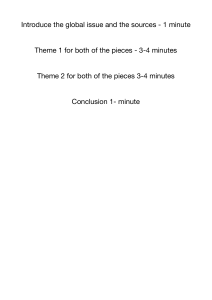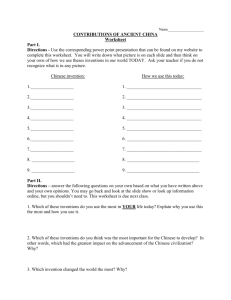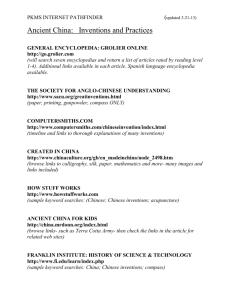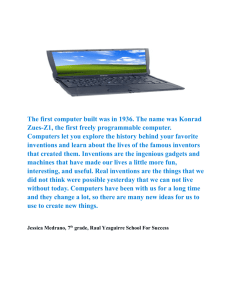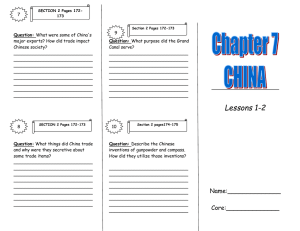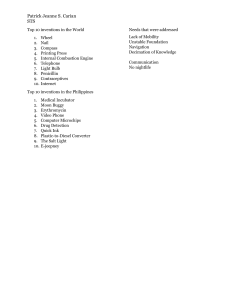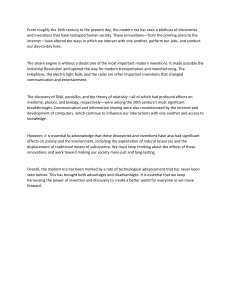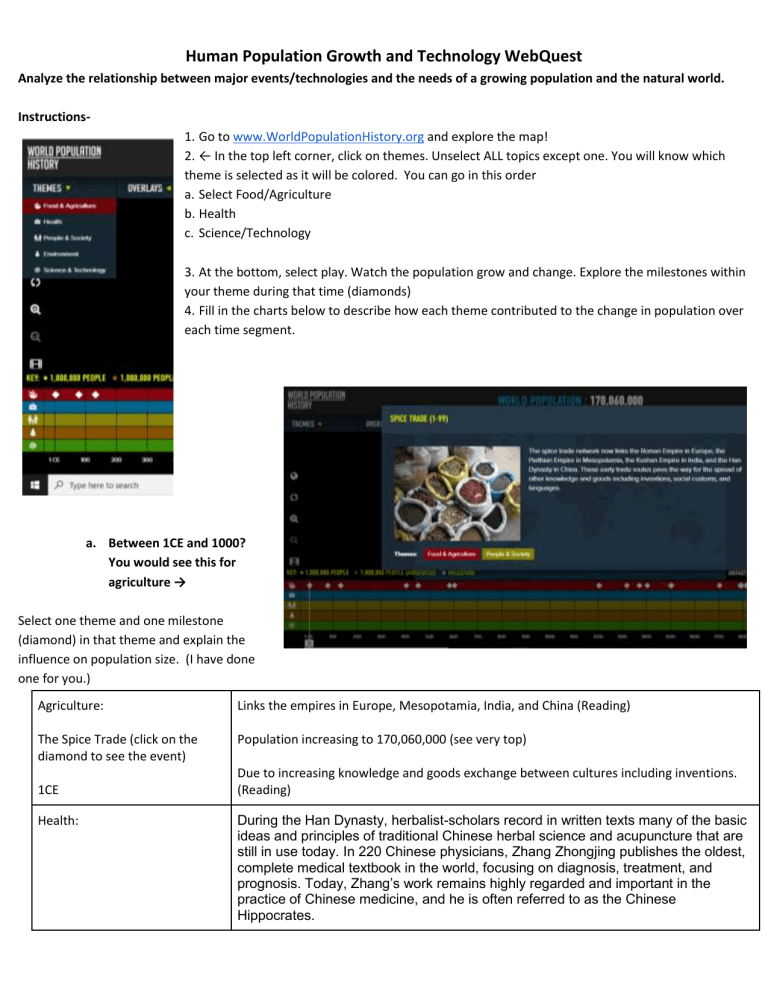
Human Population Growth and Technology WebQuest Analyze the relationship between major events/technologies and the needs of a growing population and the natural world. Instructions1. Go to www.WorldPopulationHistory.org and explore the map! 2. ← In the top left corner, click on themes. Unselect ALL topics except one. You will know which theme is selected as it will be colored. You can go in this order a. Select Food/Agriculture b. Health c. Science/Technology 3. At the bottom, select play. Watch the population grow and change. Explore the milestones within your theme during that time (diamonds) 4. Fill in the charts below to describe how each theme contributed to the change in population over each time segment. a. Between 1CE and 1000? You would see this for agriculture → Select one theme and one milestone (diamond) in that theme and explain the influence on population size. (I have done one for you.) Agriculture: Links the empires in Europe, Mesopotamia, India, and China (Reading) The Spice Trade (click on the diamond to see the event) Population increasing to 170,060,000 (see very top) 1CE Health: Due to increasing knowledge and goods exchange between cultures including inventions. (Reading) During the Han Dynasty, herbalist-scholars record in written texts many of the basic ideas and principles of traditional Chinese herbal science and acupuncture that are still in use today. In 220 Chinese physicians, Zhang Zhongjing publishes the oldest, complete medical textbook in the world, focusing on diagnosis, treatment, and prognosis. Today, Zhang’s work remains highly regarded and important in the practice of Chinese medicine, and he is often referred to as the Chinese Hippocrates. Technology The horse collar is invented in China. Its implementation would lead to horses replacing oxen as the primary plow animals, taking advantage of their speed and endurance. Food production increased in Asia as a result of this change, as did the working day which gained 2-3 additional hours of productivity. b. Between 1000 and 1400? Agriculture: The blast furnace technology, long used in Ancient China, makes its way to Europe. Europeans refine the furnace to make it more efficient. They use the resulting iron to make stronger axes, horse harnesses, and plows, allowing them to cultivate more from the land. Health: Persian philosopher, Ibn Sina (Avicenna) completes The Canon of Medicine, a fivevolume encyclopedia of all medical knowledge known at that time. It is considered one of the most important books on the history of medicine and continued to be the standard medical reference throughout Western Europe through the Middle Ages. Technology Cloth fulling mills are disseminated from the Islamic World into Europe. This is the first step in the mechanization of cloth milling, which later plays an important role in the Industrial Revolution. c. Between 1400 and 1700? (HINT- ZOOM IN ON THE TIMELINE AT THE BOTTOM if you need to separate the diamonds. Use the + and - in the lower right) Agriculture: Beginning in the 16th century and continuing for 366 years, between 12-15 million Africans were enslaved and transported to the Americas. The Trans-Atlantic Slave Trade was the largest forced migration of people in history. The labor of enslaved Africans was foundational for the production of cash crops such as sugar and tobacco in the Americas. Health: Smallpox is believed to have arrived in the Americas on a Spanish ship. As soon as the ship landed in Mexico, the infection began its deadly spread through the continent, killing at least one-third of the indigenous population, who had never been exposed and had no immunity. Technology Johannes Gutenberg invents the printing press and moveable type in Germany. This invention leads to an era of mass communication and a rapid spread of ideas and concepts, permanently altering society and social structures. The Bible is the first book printed. d. Between 1700 and 1900? Agriculture: Scottish mechanical engineer Andrew Meikle invents the first practical threshing machine to separate grains from stalks and husks, saving great amounts of time in agricultural labor. Health: Alexander Cummings, a Scottish watchmaker, patents the first flush toilet using the S-trap feature which laid the foundation for modern flush toilets. Thomas Crapper added widespread popularity and several refinements to this invention a hundred years later. The flush toilet had a profound impact on public health, allowing residents of cities to transport human wastes (via sewage systems) out of crowded households and city streets. Technology President Thomas Jefferson commissions Meriwether Lewis and William Clark to explore and map the western United States shortly after the Louisiana Purchase. With the accompaniment and expertise of Sacagawea, a Shoshone Native American guide, their two-year expedition led to the western expansion of the country’s population. e. Between 1900 and today? Agriculture: While working in West Africa, Jamaican pediatrician Cicely Williams discovers “kwashiorkor,” a condition of advanced malnutrition due to insufficient protein intake. It is most commonly seen among children in developing countries beset by droughts and famine. Health: The first birth control clinic in the U.S. opens in Brooklyn, NY. After only being open for ten days, the authorities shut down the clinic and arrested founder Margaret Sanger with crimes related to sharing birth control information. Technology World War I saw the advancement of new deadly weapons including tanks, poison gas, and flamethrowers. One of the deadliest conflicts in human history, it led to over 37 million casualties (9-16 million deaths). 5. Make a Graph of the population numbers and dates you recorded in your table. You will put the years on the bottom and connect the 5 dots. For extra credit, you can add 5 more dots at midpoints in your timeline. For example, if you have a dot a 1 year and then at 1500, maybe find a population dot for year 700. To put your image in this document, go to INSERT, click on IMAGE, select CAMERA. Take a picture of your graph and insert it here. 6. Using what you learned, discuss two of the following four questions in paragraph form (5-6 sentences each). This should include milestone examples from the website. → How have human needs changed through history? What are some results that have come of these changes? → How have major events and inventions changed the number of resources each human needs? What are the impacts of these events/inventions on the environment? → How have actions taken to deal with the demands of a rapidly growing population affected the natural environment, for better or for worse? → Do we currently meet human needs worldwide? Is it possible to meet all the needs of the current global population? How have major events and inventions changed the number of resources each human needs? What are the impacts of these events/inventions on the environment? For thousands of years, humans have modified the physical environment by clearing land for agriculture or damming streams to store and divert water. As we industrialized, we built factories and power plants. While these modifications directly impact the local environment, they also impact environments farther away due to the interconnectivity of Earth’s systems. For example, when a dam is built, less water flows downstream. This impacts the communities and wildlife located downstream who might depend on that water. Do we currently meet human needs worldwide? Is it possible to meet all the needs of the current global population? Throughout history, the dynamic nature of human needs has prompted discoveries, inventions, and in some cases, revolutions. But there are parts of the world where people now live beyond the Earth’s ecological means. Energy use, farmland demands, and overharvesting of ocean ecosystems are all examples of how human needs are outstripping the Earth’s natural ability to regenerate natural resources. However, there are other regions where populations’ basic needs are not supported due to social or political instability, or environmental volatility. Our ability to satisfy current and future needs requires sustainable solutions that will allow future generations to meet their needs without seriously endangering the planet’s limited resources. Looking to the past for examples, we can find instances where population pressures influenced our ability to meet human needs, and where that need has sparked or necessitated a change in the way that things were done.
